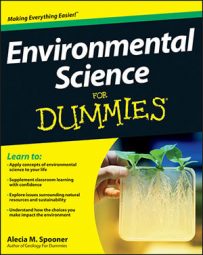A common way that humans pollute water is through the addition of nutrients (fertilizers and sewage) to water as nonpoint source pollution. These added materials are full of nitrogen and phosphorus, two nutrients that encourage the growth of aquatic producers, such as algae. The excessive growth of algae dramatically disrupts the entire ecosystem. Because this type of pollution results from excess nutrients, it’s called nutrient pollution.
Bodies of water naturally exist with different nutrient levels:
Waters that have low levels of nutrients and, therefore, low numbers of producers and low biological productivity are called oligotrophic. Oligotrophic waters are clear without many microscopic algae plants.
Waters that have high levels of nutrients and, therefore, high biological productivity with large algae populations are called eutrophic.
The transition from oligotrophic to eutrophic — called eutrophication —occurs naturally over time as a type of community succession in lakes and ponds. Additional sediment and nutrients enter the ecosystem via streams, rainwater runoff, and other sources. Eventually, the biological activity and plant growth in the lake or pond increase to a degree that it may no longer be a lake or pond, becoming instead a wetland.
When humans pollute water with nutrients, this normally long, slow process of eutrophication occurs very rapidly and is called cultural eutrophication. The rate of cultural eutrophication is much faster than natural rates of eutrophication; as a result, the organisms in the ecosystem don’t have time to adapt to the changes and die. Here’s what the cultural eutrophication process looks like:
Pollution enters the water, adding sediment, nitrogen, and phosphorus (the nutrients).
The added nutrients fuel algae growth; algae begin to reproduce in huge numbers, creating what’s often called an algae bloom.
The algae population continues to grow until it runs out of either nutrients or space — covering the surface of the water completely.
Extensive algae across the surface of the water blocks sunlight from reaching organisms below the surface of the water, such as aquatic plants.
Underwater plants begin to die from lack of sunlight, while the large algae population, having reached its limit, also begins to die, sinking into the water where bacteria decompose it.
Decomposition of dead plants and algae by bacteria consumes the dissolved oxygen in the water, creating oxygen sag conditions.
Fish and other oxygen-breathing organisms suffocate from lack of oxygen, and the entire aquatic ecosystem collapses, creating one big dead zone.
Cultural eutrophication doesn’t occur only in lakes. Coastal waters also experience the effects of nutrient pollution and cultural eutrophication. As a result, highly polluted areas of water become dead zones that don’t have enough oxygen to support a healthy aquatic ecosystem.
One of the most studied dead zones from nutrient pollution occurs in the Gulf of Mexico. The Mississippi River flows into the gulf and brings with it nutrient runoff from agricultural fields in the Midwestern United States. For a long time, scientists didn’t understand what was causing huge numbers of fish to die off and whole regions of the Gulf of Mexico to display low levels of dissolved oxygen.
After observing the ecosystem for a number of years, scientists realized that the worst dead zones occur after spring rains along the Mississippi River. These rains wash fertilizers and manure from agricultural fields into the river, which then carries these nutrients into the gulf. When these nutrients reach the gulf, the cycle of cultural eutrophication begins with an algae bloom and subsequent ecosystem disruption.
This pollution scenario isn’t unique to the Gulf of Mexico. It’s also common in other regions, such as the Mediterranean Sea and the Black Sea. In most cases, the dead zones are a recurring event; after the ecosystem recovers, a fresh flow of nutrients occurs and the cycle repeats itself.
Many cities have begun to monitor and limit the amount of nitrogen and other nutrients that enter nearby aquatic ecosystems in an effort to control nutrient pollution, oxygen sag, and cultural eutrophication. Another way to solve this type of water pollution problem is by finding ways to clean sewage and wastewater before it enters and damages an ecosystem.

